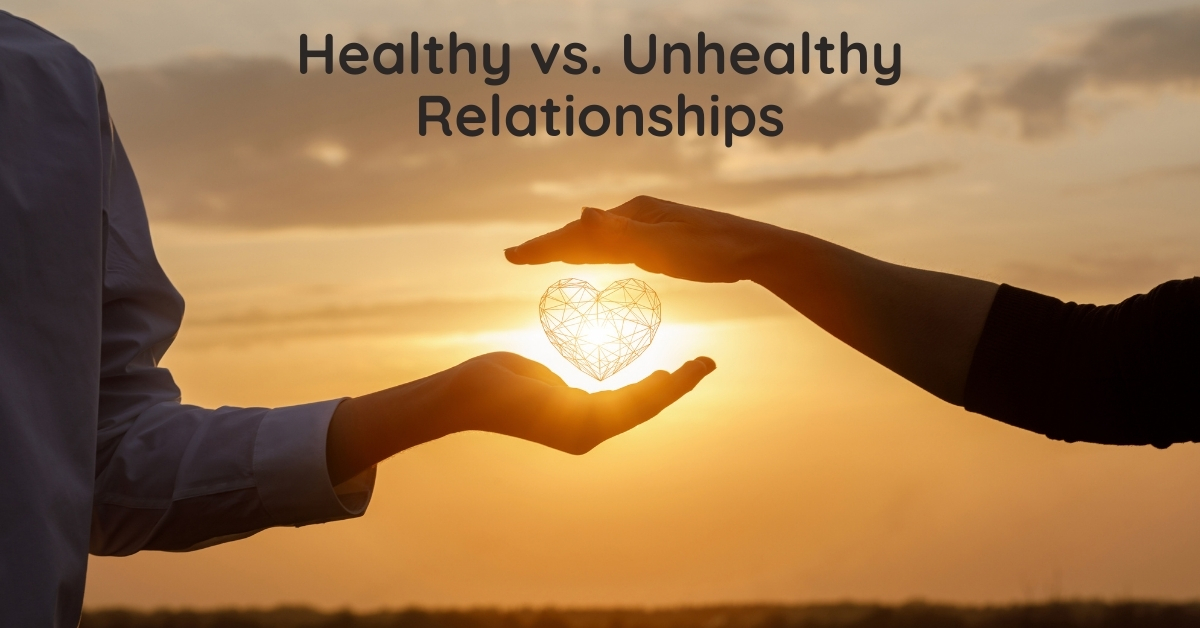Relationships are a fundamental part of human existence, shaping our lives and influencing our well-being. Whether romantic, familial, or platonic, the quality of our relationships can significantly impact our mental and emotional health.
In this blog post guide, we will explore the spectrum of relationship dynamics, helping you distinguish between healthy and unhealthy patterns, and providing strategies for cultivating positive connections.
Key Takeaways
- Healthy relationships are built on mutual respect, trust, and support, while unhealthy ones involve control, disrespect, and harm.
- Essential components of healthy relationships include effective communication, healthy boundaries, and individual growth.
- Warning signs of unhealthy relationships include manipulation, lack of trust, poor communication, and emotional or physical abuse
- Navigating challenges in relationships requires constructive conflict resolution and balancing individual needs with partnership expectations.
- Building healthy relationships involves ongoing self-reflection, developing communication skills, and nurturing trust and intimacy.
- Recognize when to seek professional help or support for relationship issues or personal safety concerns.
- Continuously assess your relationships and work on cultivating healthy relationship skills for overall well-being and happiness.
The Spectrum of Relationship Dynamics
Relationships exist on a continuum, ranging from deeply fulfilling and supportive to toxic and harmful. Understanding this spectrum is crucial for recognizing the health of your own relationships and making informed decisions about your interpersonal connections.
Defining Healthy Relationships
Healthy relationships are characterized by mutual respect, trust, and support. They foster individual growth while maintaining a strong connection between partners. In a healthy relationship, both individuals feel valued, heard, and free to be themselves.
Recognizing Unhealthy Patterns
Unhealthy relationships, on the other hand, often involve patterns of control, disrespect, and emotional or physical harm. These relationships can be draining, causing stress and negatively impacting one’s self-esteem and overall well-being.
Key Components of Healthy Relationships
To better understand what constitutes a healthy relationship, let’s explore the essential elements that contribute to positive and fulfilling connections.
1. Mutual Respect and Equality
In a healthy relationship, both partners value each other’s thoughts, feelings, and boundaries. There is a sense of equality, with neither partner dominating decision-making or exerting control over the other.
2. Effective Communication
Open, honest, and respectful communication is the cornerstone of a healthy relationship. Partners should feel comfortable expressing their needs, concerns, and emotions without fear of judgment or retaliation.
3. Trust and Honesty
Trust forms the foundation of any strong relationship. Both partners should be reliable, transparent, and committed to maintaining each other’s trust through consistent actions and words.
4. Support and Encouragement
Healthy relationships involve partners who uplift and support each other’s goals and aspirations. This mutual encouragement fosters personal growth and strengthens the bond between individuals.
5. Healthy Boundaries
Respecting each other’s personal space, time, and individuality is crucial in a healthy relationship. Partners should feel comfortable setting and maintaining boundaries without guilt or pressure.
6. Individual Identity and Growth
While sharing a connection, partners in a healthy relationship maintain their own identities, interests, and friendships. They encourage each other’s personal growth and independence.
Warning Signs of Unhealthy Relationships
Recognizing the red flags of unhealthy relationships is crucial for protecting your well-being and making informed decisions about your connections.
1. Control and Manipulation
One partner consistently making decisions for the other or using guilt, threats, or coercion to influence behavior is a clear sign of an unhealthy dynamic.
3. Lack of Trust and Dishonesty
Frequent lying, hiding information, or invading privacy indicates a breakdown of trust, which is essential for a healthy relationship.
4. Poor Communication and Conflict Resolution
Constant arguments, inability to discuss issues calmly, or avoiding important conversations altogether can signal an unhealthy pattern in the relationship.
5. Disrespect and Criticism
Persistent put-downs, mockery, or dismissal of one’s feelings and opinions erode self-esteem and indicate a lack of respect in the relationship.
6. Jealousy and Possessiveness
While some jealousy can be normal, excessive possessiveness or attempts to isolate a partner from friends and family are unhealthy behaviors.
7. Emotional or Physical Abuse
Any form of physical violence, emotional manipulation, or verbal abuse is a severe indicator of an unhealthy and potentially dangerous relationship.
Navigating Challenges in Relationships
Even healthy relationships face challenges. The key is how partners approach and resolve these issues together.
1. Addressing Conflict Constructively
Healthy relationships involve partners who can discuss disagreements respectfully, focus on finding solutions rather than placing blame, and are willing to compromise.
2. Maintaining Individual Identity
Balancing togetherness with individual pursuits is essential. Partners should support each other’s personal interests and respect the need for alone time.
3. Balancing Needs and Expectations
Open communication about each partner’s needs, desires, and expectations helps maintain a healthy balance in the relationship.
Building and Maintaining Healthy Relationships
Cultivating a healthy relationship requires ongoing effort and commitment from both partners.
1. Self-Reflection and Personal Growth
Taking time for self-improvement and addressing personal issues contributes to healthier interactions within the relationship.
2. Developing Communication Skills
Practicing active listening, expressing feelings clearly, and learning to communicate effectively during conflicts are vital skills for maintaining a healthy relationship.
3. Establishing and Respecting Boundaries
Clearly communicating personal boundaries and respecting those of your partner helps maintain a healthy balance of individuality and togetherness.
4. Nurturing Trust and Intimacy
Building trust through consistent actions, honesty, and vulnerability fosters a deeper connection and intimacy between partners.
5. Seeking Help and Support
Sometimes, professional help or external support may be necessary to address relationship issues or ensure personal safety.
6. Recognizing When to Seek Help
If you’re consistently unhappy, feel unsafe, or are unable to resolve conflicts, it may be time to seek professional guidance or support from trusted individuals.
7. Available Resources and Support Systems
Various resources are available for those in need of relationship support or assistance:
| Resource Type | Examples |
|---|---|
| Professional Help | Couples counseling, individual therapy |
| Support Groups | Domestic violence support groups, relationship workshops |
| Helplines | National Domestic Violence Hotline, Crisis Text Line |
| Online Resources | Relationship education websites, self-help books |
8. Creating a Safety Plan (if necessary)
For those in potentially dangerous relationships, developing a safety plan with the help of professionals or trusted individuals is crucial.
Moving Forward
Regardless of your current relationship status, there are steps you can take to foster healthier connections in your life.
1. Assessing Your Current Relationships
Take time to reflect on your relationships, identifying both positive aspects and areas that may need improvement.
2. Making Informed Decisions
Armed with knowledge about healthy and unhealthy relationship patterns, you can make more informed choices about your current and future relationships.
Cultivating Healthy Relationship Skills
Continuously work on developing skills that contribute to healthy relationships, such as effective communication, emotional intelligence, and boundary-setting.
By understanding the characteristics of healthy and unhealthy relationships, you can take proactive steps to cultivate positive connections in your life. Remember, every relationship requires effort and commitment, but the rewards of a healthy, supportive partnership are immeasurable.
Whether you’re working to improve an existing relationship or seeking new connections, prioritizing these healthy relationship principles will contribute to your overall well-being and happiness.







